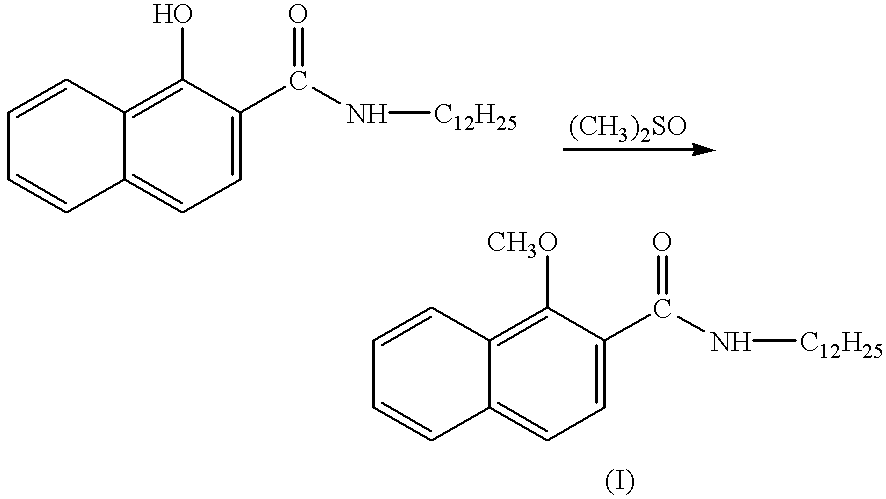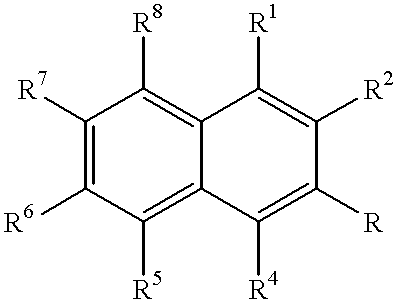Radiation curable silicone composition
- Summary
- Abstract
- Description
- Claims
- Application Information
AI Technical Summary
Problems solved by technology
Method used
Image
Examples
examples 10-14
[0065] Several catalyst solutions, each based on bis(alkylphenyl)iodonium hexafluorophosphate ("IPF.sub.6") were made, each including a different combination of various additives, that is, N-dodecyl-1-hydroxy-2-naphthal-enecarboxamide ("DDHNA"), CPTX and / or IPTX, in the relative amounts set forth in TABLE II below. The coating compositions of Examples 10-14 were each made by blending 4 pbw of a respective one of the catalyst solutions with 100 pbw of an oxa-acid modified epoxy siloxane which was prepared by reaction of 100 pbw of the M.sup.ED.sub.4.sup.ED.sub.85M.sup.E epoxysilicone polymer described above with 2 pbw of 3,6,9-trioxodecanoic acid, as described in U.S. Pat. No. 5,271,290. All blends of the catalyst solutions and oxo-acid modified epoxy silicone polymer were clear, stable solutions.
[0066] The comparative cure determinations for compositions of Examples 10-14 were conducted on hand-drawn 0.5 mil thick samples on polykraft substrate, using a Fusion Systems Lab UV Process...
examples 15-16
[0068] DDHNA was then treated with dimethoxysulfoxide to convert the OH group of DDHNA to a methoxy group, according the reaction (I): 2
[0069] The product, N-dodecyl-1-methoxy-2-naphthalenecarboxamide (DDMNA) was soluble in the oxa-acid modified epoxy silicone polymer 475-10-1633.
[0070] Two IPF.sub.6-based catalyst solutions, each including 45 wt % IPF.sub.6, 45 wt % DAA and 10 wt % of either DDHMA or DDMNA, were made. The coating compositions of Examples 15 and 16 were each made by blending 4 pbw of a respective one of the catalyst solutions with the oxo-acid modified epoxy silicone polymer described above. The cure speed of the coating compositions of Examples 15 and 16 was determined according to the procedure described in Examples 10-14 above. The naphthol component of each of the catalyst packages and maximum conveyer speed results are set forth below in TABLE III for the coating compositions of Examples 15 and 16.
3TABLE III Ex # Additive Conveyor Speed.sup.2 (fpm) 15 DDHNA 25 ...
examples 17-24
[0071] Catalyst solutions consisting of 50% IPF.sub.6, 10% naphthol additive and 40% DAA diluent were prepared. The coating compositions of Examples 17 to 24 were each made by blending 4 pbw of a respective one of the catalyst solutions with 100 pbw of the oxo-acid modified epoxy silicone polymer described above in Examples 10-14. The maximum conveyer speed for curing of each of the compositions of Examples 17 to 24 was determined according to the procedure described in Examples 10-14 above. The naphthol compound used in the catalyst solution and the conveyor speed results are set forth below in TABLE IV for Examples 17-24.
4TABLE IV Ex # Additive Conveyor Speed (fpm) 17 1,4-dihydroxynaphthalene 32 18 2,3-dihydroxynaphthalene 20 19 2,6-dihydroxynaphthalene 25 20 1,5-dihydroxynaphthalene 32 21 1,6-dihydroxynaphthalene 30 22 2,7-dihydroxynaphthalene 25 23 4-methoxy-1-naphthol 25 24 7-methoxy-2-naphthol 15
[0072] The results indicate that each of the naphthol compounds used in Examples 1...
PUM
| Property | Measurement | Unit |
|---|---|---|
| Percent by mass | aaaaa | aaaaa |
| Percent by mass | aaaaa | aaaaa |
| Percent by mass | aaaaa | aaaaa |
Abstract
Description
Claims
Application Information
 Login to View More
Login to View More - R&D
- Intellectual Property
- Life Sciences
- Materials
- Tech Scout
- Unparalleled Data Quality
- Higher Quality Content
- 60% Fewer Hallucinations
Browse by: Latest US Patents, China's latest patents, Technical Efficacy Thesaurus, Application Domain, Technology Topic, Popular Technical Reports.
© 2025 PatSnap. All rights reserved.Legal|Privacy policy|Modern Slavery Act Transparency Statement|Sitemap|About US| Contact US: help@patsnap.com



